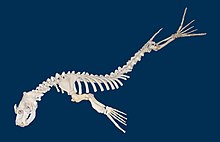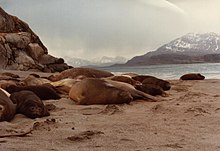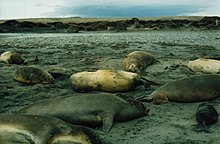Southern elephant seal
| Southern elephant seal Temporal range:
recent | |
|---|---|

| |
| Male (bull) | |

| |
| Females (cows) and pups | |
| Scientific classification | |
| Domain: | Eukaryota |
| Kingdom: | Animalia |
| Phylum: | Chordata |
| Class: | Mammalia |
| Order: | Carnivora |
| Clade: | Pinnipedia |
| Family: | Phocidae |
| Genus: | Mirounga |
| Species: | M. leonina
|
| Binomial name | |
| Mirounga leonina | |

| |
| Southern elephant seal range | |
| Synonyms | |
|
Phoca leonina Linnaeus, 1758 | |
The southern elephant seal (Mirounga leonina) is one of two
Taxonomy
The southern elephant seal was one of the many species originally described by Swedish zoologist Carl Linnaeus in the landmark 1758 10th edition of his Systema Naturae, where it was given the binomial name of Phoca leonina.[3] John Edward Gray established the genus Mirounga in 1827.[10]
In the nineteenth century, the species was often called "bottle-nosed seal".[11]
Description

The southern elephant seal is distinguished from the northern elephant seal (which does not overlap in range with this species) by its greater body mass and a shorter proboscis. The southern males also appear taller when fighting, due to their tendency to bend their backs more strongly than the northern species. This species may also exhibit the greatest sexual dimorphism of any mammal in terms of mass ratio, with males typically five to six times heavier than females.[12] On average female southern elephant seals weigh 350 to 900 kg (770 to 1,980 lb) and measure 2.6 to 3 m (8.5 to 9.8 ft) long, whereas bulls can range from 1,500 to 3,700 kg (3,300 to 8,200 lb) and grow to 4.2 to 5.8 m (14 to 19 ft) in length.[13][14] For comparison, among the northern elephant seal and the sperm whale (Physeter macrocephalus)—two other large marine mammals that are highly sexual dimorphic by size—males typically outweigh females by a factor of three to four.[15]
Southern elephant seal size also varies regionally. Studies have indicated elephant seals from South Georgia are around 30% heavier and 10% longer on average than those from Macquarie Island.[12] The record-sized bull, shot in Possession Bay, South Georgia, on 28 February 1913, measured 6.85 m (22.5 ft) long and was estimated to weigh 5,000 kg (11,000 lb), although it was only partially weighed piecemeal.[9][16] The maximum size of a female is 1,000 kg (2,200 lb) and 3.7 m (12 ft).[9][17]
A southern elephant seal's eyes are large, round, and black. The width of the eyes, and a high concentration of low-light pigments, suggest sight plays an important role in the capture of prey. Like all seals, elephant seals have hind limbs whose ends form the tail and tail fin. Each of the "feet" can deploy five long, webbed fingers. This agile dual palm is used to propel water. The
Pups are born with fur and are completely black. Their coats are unsuited to water, but protect infants by insulating them from the cold air. The first moulting accompanies weaning. After moulting, the coats may turn grey and brown, depending on the thickness and moisture of hair. Among older males, the skin takes the form of a thick leather which is often scarred.
Like other seals, the
Range and population
The world population was estimated at 650,000 in the mid-1990s,[1] and was estimated in 2005 at between 664,000 and 740,000.[18] Studies have shown the existence of three geographic subpopulations, one in each of the three oceans.
Tracking studies have indicated the routes traveled by elephant seals, demonstrating their main feeding area is at the edge of the Antarctic continent. While elephant seals may come ashore in Antarctica occasionally to rest or to mate, they gather to breed in subantarctic locations.

The largest subpopulation is in the South Atlantic, with more than 400,000 individuals, including about 113,000 breeding females on
The second subpopulation, in the south Indian Ocean, consists of up to 200,000 individuals, three-quarters of which breed in the Kerguelen Islands and the rest in the Crozet Islands, Marion and Prince Edward Islands, and Heard Island. Some individuals also breed on Amsterdam Island.

The third subpopulation of about 75,000 seals is found in the subantarctic islands of the Pacific Ocean south of Tasmania and New Zealand, mainly Macquarie Island.
Colonies once existed in Tasmania, Saint Helena, and the Juan Fernández Islands off the coast of Chile. Some individuals at the time of moulting have been found in South Africa, Australia or Uruguay. Lost animals have also been reported from time to time on the shores of Mauritius, with two reports from the Río Guayas estuary area in Ecuador[18] and a beach in Lima, Peru.[20] Reality of the creature so called Manatee of Helena had been pointed out as possible misidentification of elephant seals historically present on Saint Helena.[21]
In Chile, the species is currently believed to be in a process of re-colonization of its former range.[22][23] It has for example been sighted in the 2010s at the mouth of Toltén River and at the Caicura Islets.[23][24]
After the end of large-scale seal hunting in the 19th century, the southern elephant seal recovered to a sizable population in the 1950s; since then, an unexplained decline in the subpopulations of the Indian Ocean and Pacific Ocean has occurred. The population now seems to be stable; the reasons for the fluctuation are unknown. Suggested explanations include a phenomenon of depression following a rapid demographic rebound that depletes vital resources, a change in climate, competition with other species whose numbers also varied, or even an adverse influence of scientific monitoring techniques.[25]
Behaviour
Social behaviour and reproduction

Elephant seals are among the seals that can stay on land for the longest periods of time, as they can stay dry for several consecutive weeks each year. Males arrive in the colonies earlier than the females and fight for control of
An elephant seal must stay in his territory to defend it, which could mean months without eating, having to live on his blubber storage. Two fighting males use their weight and canine teeth against each other. The outcome is rarely fatal, and the defeated bull will flee; however, bulls can suffer severe tears and cuts. Some males can stay ashore for more than three months without food. Males commonly vocalize with a coughing roar that serves in both individual recognition and size assessment.[27] Conflicts between high-ranking males are more often resolved with posturing and vocalizing than with physical contact.[27]

Generally, pups are born rather quickly in the breeding season.[29] After being born, a newborn will bark or yap and its mother will respond with a high-pitched moan.[30] The newborn begins to suckle immediately. Lactation lasts an average of 23 days. Throughout this period, the female fasts. Newborns weigh about 40 kg (88 lb) at birth, and reach 120 to 130 kg (260 to 290 lb) by the time they are weaned. The mother loses significant weight during this time. Young weaned seals gather in nurseries until they lose their birth coats. They enter the water to practice swimming, generally starting their apprenticeship in estuaries or ponds. In summer, the elephant seals come ashore to moult. This sometimes happens directly after reproduction.
Feeding and diving

Satellite tracking revealed the seals spend very little time on the surface, usually a few minutes for breathing. They dive repeatedly, each time for more than 20 minutes, to hunt their prey—squid and fish—at depths of 400 to 1,000 m (1,300 to 3,300 ft). They are the deepest diving air-breathing non-cetaceans and have been recorded at a maximum of 2,388 m (7,835 ft) in depth.[31][32]

As for the duration, depth and sequence of dives, the southern elephant seal is the best performing seal. In many regards, they exceed even most
In the ocean, the seals apparently live alone. Most females dive in pelagic zones for foraging, while males dive in both pelagic and benthic zones.[33] Individuals will return annually to the same hunting areas. Due to the inaccessibility of their deep-water foraging areas, no comprehensive information has been obtained about their dietary preferences, although some observation of hunting behavior and prey selection has occurred.[34]
While hunting in the dark depths, elephant seals seem to locate their prey, at least in part, using vision; the
Predation
Weaned pups and juveniles may fall prey to
Conservation

After their near extinction due to hunting in the 19th century, the total population was estimated at between 664,000 and 740,000 in 2005,
Climate change
Climate change likely has a wide-ranging and diverse impact on marine species such as southern elephant seals. As top predators in the Southern Ocean, southern elephant seals inhabit one of the most sensitive and vulnerable regions to rapid climate change. Global efforts such as the Southern elephant seals as oceanographic samplers[42] and the Marine Mammals Exploring the Oceans Pole to Pole projects[43] have led to the collection of a large suite of long-term coupled behavioural-oceanographic data. As part of these projects, satellite-relay data loggers were attached to southern elephant seals to collect physical and biological data. This simultaneous collection of behavioural and environmental data, spanning more than ten years, has enabled researchers to study the impact of climate change on southern elephant seals and the Antarctic ecosystem. This data provides information on how the Southern Ocean is changing in relation to climate change as well as how these species respond to changes.[44][45]
These projects focused on southern elephant seals because they are deep divers as well as a major predator in the Southern Ocean in terms of their population size and food consumption. As predators of the upper levels of the food-web, their foraging success and population dynamics impart valuable information about productivity at different trophic levels.[46] The well-being of southern elephant seals therefore mirrors that of the whole Antarctic ecosystem.
Southern elephant seals from different colonies frequent specific oceanographic regions to forage. They feed most successfully in areas with specific hydrographic properties, e.g. the upwelling regions of Circumpolar Deep Water within the Antarctic Circumpolar Current.[47] In the Southern Ocean, southern elephant seals associate more frequently with southerly, higher‐latitude fronts and frontal zones. However, the foraging success in association with these regions varies strongly according to year, season and sex. Some of the seasonal and interannual variations in foraging success can be linked to climatic changes such as positional shifts in fronts and variability associated with frontal positions.[48] Generally, southern elephant seals appear to be resilient against the apparent variability in the location and productivity of frontal systems.
Notable individuals
One of the most famous southern elephant seals was Minazo, who lived in Japan's Enoshima Aquarium from when he was a half-year old until his death in 2005 at age 11.[49] Minazo became popular for his signature bucket-holding, tongue-lolling pose. In 2006, Minazo was memorialized by the Japanese noise musician Masami Akita, also known as Merzbow, in a two-volume album,[50][51] with artwork by Jenny Akita showing Minazo holding his beloved bucket. In 2007, Minazo became the subject of an image macro similar to lolcat called "lolrus". In his liner notes, Masami Akita suggested Minazo's frequent and demanding performances left him exhausted, contributing ultimately to his death. Akita's intention in celebrating Minazo was to highlight the plight of captive animals used for performance before public audiences.[49] Minazo has also been featured on several T-shirt designs.
In late 2023, a 600-kg (1300-lb) southern elephant seal nicknamed "Neil the Seal" became an internet sensation after repeatedly hauling out in residential areas in southern Tasmania, causing numerous issues such as preventing a woman from going to work by resting in front of her car. His repeated interactions with humans have caused concern for Neil's welfare as well as potential risks to the public.[52][53]
References
- ^ . Retrieved 19 November 2021.
- ^ "Appendices | CITES". cites.org. Retrieved 14 January 2022.
- ^ a b Linnæus, Carl (1758). Systema naturæ per regna tria naturæ, secundum classes, ordines, genera, species, cum characteribus, differentiis, synonymis, locis. Tomus I (in Latin) (10th ed.). Holmiæ: Laurentius Salvius. pp. 37–38. Retrieved 23 November 2012.
- Proceedings of the Zoological Society of London. 1881: 145–162. Retrieved 14 May 2020.
- OCLC 50815427. and(699): 385/7.
 Distant, William Lucas (September 1899). "The "Sea-Elephant" (Macrorhinus elephantinus)". The Zoologist. 4th series, vol 3
Distant, William Lucas (September 1899). "The "Sea-Elephant" (Macrorhinus elephantinus)". The Zoologist. 4th series, vol 3 - ^ "Northern Elephant Seal". The Marine Mammal Center. Retrieved 24 November 2017.
- JSTOR 3503810.
- ^ "Southern Elephant Seal". Oceana. Retrieved 23 November 2017.
- ^ ISBN 978-0-85112-235-9.
- ^ Gray, John Edward (1827). "Synopsis of the species of the class Mammalia". In Baron Cuvier (ed.). The Animal Kingdom Arranged in Conformity with its Organization, by the Baron (G) Cuvier, with additional descriptions by Edward Griffith and others. Vol. 5. Printed for G.B. Whittaker. p. 180.
- ^ e.g. Cuvier 1827-1835. The animal kingdom etc. London : Whittaker. p. 58 online in Darwin's Beagle Library.
- ^ ISBN 978-0-12-373553-9.
- ^ "Southern Elephant Seal". pinnipeds.org. Seal Conservation Society.
- ^ Block, D.; Meyer, Philip; Myers, P. (2004). "Miroun". Animal Diversity Web. The Regents of the University of Michigan. Retrieved 11 September 2010.
- ISBN 978-0-691-12757-6.
- ISBN 978-1-4027-5623-8.
- PMID 25649000.
- ^ ISSN 1676-7497.
- S2CID 140165365.
- ^ PERÚ, NOTICIAS EL COMERCIO (11 March 2016). "Elefante marino varado en playa Makaha de Miraflores [FOTOS] | LIMA". El Comercio.
- ^ Shuker K., 2014, The Beasts That Hide from Man: Seeking the World's Last Undiscovered Animals, pp.138, Cosimo, Inc.
- ^ Cárcamo, D., Pizarro, M., Orellana, M., Muñoz, L., Pavés, G., Sepúlveda, M., Durán, R., y Oliva, D. (2019). Are southern elephant seals re-invading mid-latitude grounds? New sightings and first birth records off the Chilean Coast. Polar Biology, 42, 433-440.
- ^ a b Sepúlveda, M., Pavés, G., Harrod, C., y Gómez-Uchida, D. (2019). Sighting of a Southern elephant seal Mirounga leoninain the Toltén River, southern Chile. Revista de Biología Marina y Oceanografía, 53, 375-380.
- .
- ISSN 0254-1858.
- .
- ^ .
- S2CID 53200630.
- .
- S2CID 253958921.
- PMID 24670984.
- ^ "Census of Marine Life – From the Edge of Darkness to the Black Abyss" (PDF). Coml.org. Retrieved 15 December 2009.
- .
- ^ 2002. Elephant Seal. Columbia Encyclopedia, Vol. 1, sixth Edition. New York: Columbia University Press.
- S2CID 20332839.
- doi:10.1139/z92-143.
- S2CID 24292848.
- ^ "Southern Elephant Seal (Mirounga leonina)". Seal Conservation Society. Archived from the original on 26 October 2010. Retrieved 27 November 2011.
- ^ Van Den Hoff, J., & Morrice, M. G. (2008). Sleeper shark (Somniosus antarcticus) and other bite wounds observed on southern elephant seals (Mirounga leonina) at Macquarie Island. Marine mammal science, 24(1), 239–247.
- ^ McMahon, C. R., Burton, H. R., & Bester, M. N. (1999). First-year survival of southern elephant seals, Mirounga leonina, at sub-Antarctic Macquarie Island. Polar Biology, 21(5), 279–284.
- ^ ISBN 9780125513401– via Google Books.
- ^ "SEaOS". biology.st-andrews.ac.uk.
- ^ "MEOP – Marine Mammals Exploring the Oceans Pole to Pole". meop.net.
- PMID 21558256.
- .
- ^ Charrassin, J. B.; Roquet, F.; Park, Y. H.; Bailleul, F.; Guinet, C.; Meredith, M.; Nicholls, K.; Thorpe, S.; Tremblay, Y.; Costa, D.; Göbel, Miriam (2010). "New insights into Southern Ocean physical and biological processes revealed by instrumented elephant seals". Proceedings of OceanObs 09: Sustained Ocean Observations and Information for Society (Vol. 2), Venice, Italy, 21–25 September 2009, Hall, J., Harrison D.E. & Stammer, D., Eds., ESA Publication WPP-306.
- PMID 17693555.
- ISSN 1052-7613.
- ^ a b "Popular Enoshima aquarium seal dies after 10½-year run". The Japan Times. 7 October 2005.
- AllMusic
- AllMusic
- ^ Pamela Rontziokos (22 December 2023). "Tasmania's Neil the seal has found viral fame, leaving experts concerned for his welfare | Tasmania | The Guardian". The Guardian. Retrieved 2 February 2024.
- ^ Saman Shafiq (22 December 2023). "Tasmania's viral 'Neil the Seal' gets into standoff with police: Watch". USA Today. Retrieved 2 February 2024.
Bibliography
- "Biology, threats and conservation status of the SUB-ANTARCTIC FUR SEAL AND SOUTHERN ELEPHANT SEAL in Australian waters" (PDF). Australian Government, Department of the Environment and Heritage, Canberra. 2004. Archived from the original (PDF) on 3 June 2011. Retrieved 15 August 2011.
- Block, D.; Meyer, Philip; Myers, P. (2004). "Mirounga leonina (Southern elephant seal)". Animal Diversity Web. The Regents of the University of Michigan. Retrieved 11 September 2010.
- "Mirounga leonina". Integrated Taxonomic Information System. Retrieved 24 January 2006.
- "Mirounga leonina, Southern Elephant Seal". MarineBio. The MarineBio Conservation Society. 6 April 2017.
- Perrin, W.F.; Wursig, Bernd G.; and Thewissen, J.G.M. Encyclopedia of Marine Mammals. San Diego, Calif.: Academic Press, 2002.
- "Southern Elephant Seals". Wildlife of Antarctica. Antarctic Connection. Archived from the original on 9 October 2008. Retrieved 8 October 2008.
{{cite web}}: CS1 maint: unfit URL (link) - "Southern elephant seals biology". Elephant seals. Elephant Seal Research Group. Retrieved 11 September 2010.
External links
 Media related to Mirounga leonina at Wikimedia Commons
Media related to Mirounga leonina at Wikimedia Commons- ARKive – images and movies of the southern elephant seal
- Southern Elephant Seal
- Elephant Seal Research Group
- Elephant Seal Size & Behavior on YouTube on BBC Earth
- Photos of Southern elephant seal on Sealife Collection

